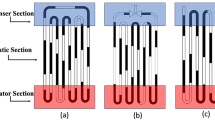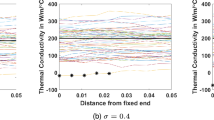Abstract
A 3-D numerical solution is implemented for investigating incompressible turbulent flow and thermal fields of film cooling through a single row of inclined cylindrical holes over a flat plate model. The effects of parameters of interest on the film cooling performance have been simulated. The group method of data handling (GMDH)-type neural networks successfully employed for modeling and presenting a correlation for area-weighted average adiabatic film cooling effectiveness.








Similar content being viewed by others
Abbreviations
- A :
-
Surface area
- \(C_{\mu }\) :
-
The turbulence model constant
- \(C_{2\varepsilon }\) :
-
The turbulence model constant
- \(C_{1\varepsilon }\) :
-
The turbulence model constant
- D :
-
Diameter of injection hole
- DR :
-
Density ratio
- I :
-
Momentum flux ratio
- k :
-
Turbulence kinetic energy
- L :
-
Length of injection hole
- M :
-
Blowing ratio
- PE :
-
Prediction error
- Pr :
-
Prandtl number
- Re :
-
Reynolds number
- T :
-
Temperature
- TE :
-
Training error
- u :
-
Velocity
- V :
-
Velocity
- VR :
-
Velocity ratio
- x :
-
Coordinate: streamwise (axial) direction
- y :
-
Coordinate: vertical direction
- \(y^{ + }\) :
-
Law of the wall coordinate
- z :
-
Coordinate: lateral (spanwise) direction
- \(\alpha\) :
-
Injection angle of hole
- \(\delta_{ij}\) :
-
Kronecker delta
- \(\varepsilon\) :
-
Turbulence dissipation rate
- \(\eta\) :
-
Adiabatic film-cooling effectiveness
- \(\mu\) :
-
Dynamic viscosity
- v :
-
Kinematic viscosity
- ρ :
-
Density
- \(\sigma_{k}\) :
-
Prandtl number for turbulence kinetic energy
- \(\sigma_{\varepsilon }\) :
-
Prandtl number for turbulence dissipation rate
- \(\tau\) :
-
Shear stresses
- aw :
-
Adiabatic wall
- c :
-
Coolant
- cl :
-
Centerline
- m :
-
Main flow
- i, j :
-
1,2 denote x–y space coordinate
- t :
-
Turbulent
- l :
-
Lateral direction
- −:
-
Average value
- ′:
-
Fluctuating component
References
Goldstein RJ (1971) Film cooling. Adv Heat Transf 7:321–379
Sinha AK, Bogard DG, Crawford ME (1991) Film-cooling effectiveness downstream of a single row of holes with variable density ratio. Trans ASME J Turbomach 113:442–449
Fric TF, Roshko A (1994) Vortical structure in the wake of a transverse jet. J Fluid Mech 279:1–47
Bogard DG, Thole KA (2006) Gas turbine film cooling. J Propuls Power 22:249–270
Yang C, Zhang J (2011) Influence of multi-hole arrangement on cooling film development. Chin J Aeronaut 25:182–188
Sargison JE, Guo SM, Oldfield MLG, Lock GD, Rawlinson AJ (2002) A converging slot-hole film-cooling geometry-part 1: low-speed flat-plate heat transfer and loss. ASME J Turbomach 124:453–460
Pedersen DR, Eckert ERG, Goldstein RJ (1997) Film-cooling with large density difference between the mainstream and the secondary fluid measured by heat mass transfer analogy. Trans ASME J Heat Transf 99:620–627
Lutum V, Johnson BV (1999) Influence of the hole length to diameter ratio on film cooling with cylindrical holes. ASME J Turbomach 121:209–216
Yuen CHN, Martinex-Botas RF (2003) Film cooling characteristics of a single round hole at various streamwise angle in a crossflow: part1 effectiveness. J Heat Mass Transf 46:221–235
Saumweber C, Schulz A, Wittig S (2003) Freestream turbulence effects on film cooling with shaped holes. ASME J Turbomach 125:65–73
Walters DK, Leylek JH (1997) A systematic computational methodology applied to a three-dimensional film-cooling flowfield. ASME J Turbomach 119:777–785
Walters DK, Leylek JH (2000) A detailed analysis of film-cooling physics: part i- streamwise injection with cylindrical holes. ASME J Turbomach 122:102–112
Leylek JH, McGovern KT (2000) A detailed analysis of film cooling physics: part ii-compound-angle injection with cylindrical holes. ASME J Turbomach 122:113–121
Astrom KJ, Eykhoff P (1971) System identification, a survey. Automatica 7:123–162
Berenji HR (1996) Computational intelligence and soft computing for space applications. IEEE Aerosp Electron Syst Mag 11:8–10
Liu GP, Kadirkamanathan V (1999) Multi-objective criteria for neural network structure selection and identification of nonlinear systems using genetic algorithms. IEE Proc Control Theory Appl 146:373–382
Ivakhnenko AG (1971) Polynomial theory of complex systems. IEEE Trans Syst Man Cybern 1:364–378
Farlow SJ (1984) Self-organizing method in modeling: GMDH-type algorithm. Dekker Inc, Marcel
Mueller JA, Lemke F (2000) Self-organizing data mining: an intelligent approach to extract knowledge from data. Pub Libri, Hamburg
Porto VW (1997) Evolutionary computation approaches to solving problems in neural computation. In: Back T, Fogel DB, Michalewicz Z (eds) Handbook of evolutionary computation. Institute of Physics Publishing and New York, Oxford University Press, Oxford
Yao X (1999) Evolving artificial neural networks. Proc IEEE 87:1423–1447
Nariman-Zadeh N, Darvizeh A, Ahmad-Zadeh GR (2003) Hybrid genetic design of GMDH-type neural networks using singular value decomposition for modelling and prediction of the explosive cutting process. Proc Inst Mech Eng Part B: J Eng Manuf 217:779–790
Nariman-Zadeh N, Darvizeh A, Felezi ME, Gharababaei H (2002) Polynomial modeling of explosive compaction process of metallic powders using GMDH-type neural networks and singular value decomposition. Modell Simul Mater Sci Eng 10:727–744
Nariman-Zadeh N, Darvizeh A, Darvizeh M, Gharababaei H (2002) Modelling of explosive cutting process of plates using GMDH-type neural network and singular value decomposition. J Mater Process Technol 128:80–87
Jamali A, Nariman-zadeh N, Darvizeh A, Masoumi A, Hamrang S (2008) Multi-objecive evolutionary optimization of polynomial neural networks for modeling and prediction of explosive cutting process. J Eng Appl Artif Intell 22:676–687
Amanifard N, Nariman-Zadeh N, Borji M, Khalkhali A, Habibdoust A (2008) Modelling and pareto optimization of heat transfer and fluid flow coefficients in microchannels using GMDH type neural networks and genetic algorithms. J Energy Convers Manag 49:311–325
Lee KD, Kim KY (2009) Optimization of fan-shaped holes for film cooling using a surrogate model, ASME Turbo Expo 2009: power for land, sea, and air (GT2009-59520) 505–514
Lee KD, Kim KY (2010) Shape optimization of a Laidback fan-shaped film-cooling hole to enhance cooling performance. ASME Turbo Expo (GT2010-22398)
Nguyen C, Rodriguez S, Zuniga H, Ho S, Kapat J (2009) Sensitivity analysis of flow conditions and geometric parameters on the film cooling effectiveness for a flat test plate, part 1: single row of cylindrical holes film cooling. ASME 2009 heat transfer summer conference collocated with the interPACK09 and 3rd Energy sustainability conferences (HT2009) 529–538
Bell CM, Hamakawa H, Ligrani PM (2000) Film cooling from shaped holes. ASME J Heat Transf 122:224–232
Brittingham RA, Leylek JH (2002) A detailed analysis of film cooling physics: part IV-compound-angle injection with shaped holes. ASME J Turbomach 122:133–145
Johnson PL, Nguyen CQ, Ho SH, Kapat JS (2010) Sensitivity analysis of domain considerations for numerical simulations of film cooling. ASME Int Heat Transf Conf 5:285–300
Acknowledgments
The authors would like to thank Dr. Ali Jamali in the mechanical engineering department at the University of Guilan for his very valuable discussions in modeling using GMDH-type neural networks.
Author information
Authors and Affiliations
Corresponding author
Rights and permissions
About this article
Cite this article
Naghashnejad, M., Amanifard, N. & Deylami, H.M. A predictive model based on a 3-D computational approach for film cooling effectiveness over a flat plate using GMDH-type neural networks. Heat Mass Transfer 50, 139–149 (2014). https://doi.org/10.1007/s00231-013-1239-3
Received:
Accepted:
Published:
Issue Date:
DOI: https://doi.org/10.1007/s00231-013-1239-3




